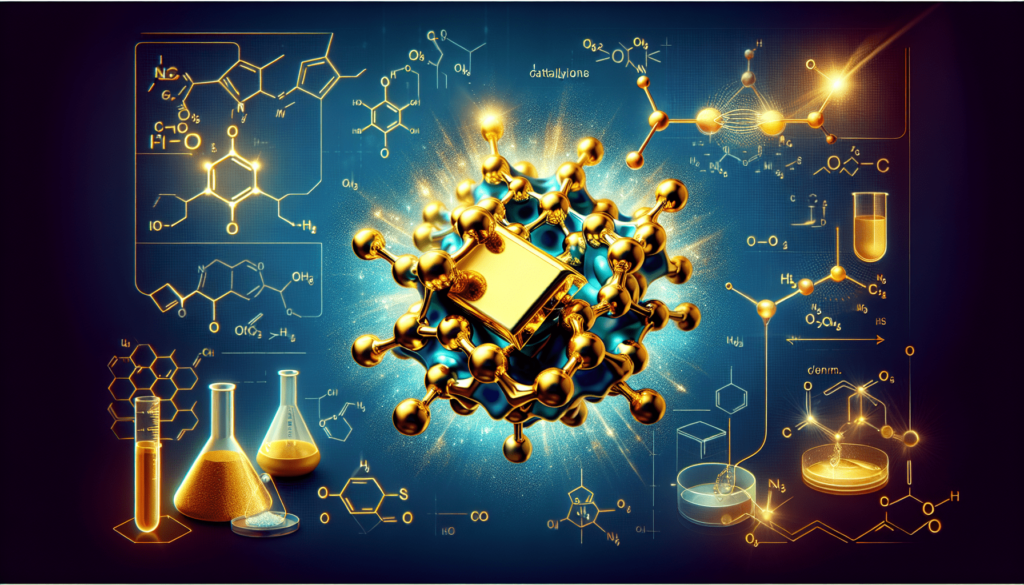In the exciting world of scientific research, gold has emerged as a catalyst of great potential. From organic synthesis to fuel cell development, this precious metal has proven its effectiveness in accelerating chemical reactions. Today, we will explore the fascinating role that gold plays as a catalyst in various scientific processes, uncovering its unique properties and the promising future it holds in the field. So, buckle up and prepare to be amazed by the golden touch of science!

Introduction
If you’ve ever thought about the valuable properties of gold, you might have considered its beautiful appearance or its use in jewelry. But did you know that gold also plays a crucial role as a catalyst in various scientific reactions? Catalysis is a process that accelerates chemical reactions without being consumed in the process. In this article, we will explore the catalytic role of gold, particularly in the form of gold nanoparticles, in a wide range of applications, from organic synthesis to industrial processes.
Definition of Catalyst
Before delving into the fascinating world of gold catalysts, let’s start by understanding what exactly a catalyst is. A catalyst is a substance that speeds up the rate of a chemical reaction by providing an alternative pathway with lower activation energy. It allows reactions to occur more quickly and efficiently, without being consumed or undergoing any permanent changes itself. Catalysts play a vital role in various industries, enabling the production of countless products and advancements in scientific research.
Overview of Gold
Gold, with its distinctive yellow color and high value, has captivated human beings for centuries. It is one of the most precious metals, symbolizing wealth, luxury, and prestige. Beyond its aesthetic appeal, gold possesses remarkable physical and chemical properties that make it an excellent candidate for catalytic applications.
Properties of Gold
Physical Properties
One of the most remarkable physical properties of gold is its exceptional malleability. Gold is the most ductile and malleable metal known to us, meaning it can be easily stretched into wires or hammered into thin sheets without breaking. This unique property allows scientists to create gold nanoparticles, opening up a whole new avenue of catalytic possibilities.
In addition, gold possesses excellent thermal and electrical conductivity. These properties, combined with its resistance to tarnish and corrosion, make gold a sought-after material in electronics and numerous other industries.
Chemical Properties
From a chemical standpoint, gold is relatively unreactive. It resists oxidation, even at high temperatures, making it an ideal catalyst in various chemical reactions. Gold can withstand harsh environments and maintain its catalytic activity over extended periods, ensuring its longevity and stability in industrial processes.

Catalytic Role of Gold
Gold may not be the first element that springs to mind when thinking about catalysts since it tends to be more commonly associated with decorative purposes. However, gold, particularly in nanoparticle form, has gained recognition for its exceptional catalytic properties. The unique behavior of gold catalysts is attributed to their distinct electronic structure, which differs from bulk gold.
Gold Nanoparticles as Catalysts
Gold nanoparticles, tiny particles with diameters ranging from 1 to 100 nanometers, have emerged as promising catalysts with a diverse range of applications. The synthesis of gold nanoparticles involves the reduction of gold salts in the presence of a stabilizing agent, such as citrate or polymers. These nanoparticles possess a high surface area-to-mass ratio, allowing for increased catalytic activity and efficiency.
Synthesis of Gold Nanoparticles
Several methods exist for synthesizing gold nanoparticles, including chemical reduction, electrochemical techniques, and the use of stabilizing agents. Each method offers varying control over the size, shape, and surface properties of gold nanoparticles, making them adaptable for specific catalytic applications.
Mechanism of Catalysis
The precise mechanism by which gold nanoparticles catalyze reactions is a topic of ongoing research. However, it is believed that their unique electronic structure, combined with their high surface area, plays a significant role. Gold nanoparticles can adsorb reactant molecules on their surface, facilitating the reaction by reducing the activation energy required for the chemical transformation to occur.
Applications of Gold Nanoparticles
Gold nanoparticles find utility in numerous applications, both in academic research and industrial processes. They have shown remarkable catalytic activity in various organic transformations, such as oxidation, reduction, carbon-carbon bond formation, and carbon-heteroatom bond formation. Furthermore, gold nanoparticles have demonstrated potential in environmental remediation, energy production, and medical fields, showcasing their versatility and importance in modern science.
Gold as a Heterogeneous Catalyst
While gold nanoparticles offer exciting possibilities, gold catalysts in the form of supported materials, such as gold nanoparticles deposited on a solid support, have also shown great efficacy in catalytic reactions. This concept, known as heterogeneous catalysis, involves the use of a solid catalyst in contrast to the liquid or gaseous reactants.
Supported Gold Catalysts
Supported gold catalysts are prepared by depositing gold nanoparticles onto a solid support material, such as carbon, zeolites, or metal oxides. The support acts as a framework, providing stability and enhancing catalytic performance. By tuning the characteristics of the support material, such as its surface area or porosity, researchers can optimize the reaction conditions and improve catalyst efficiency.
Mechanism of Heterogeneous Catalysis
In heterogeneous catalysis, the reactant molecules diffuse onto the surface of the catalyst, where the desired chemical transformation takes place. The solid support provides a platform for reactant adsorption and facilitates the reaction by lowering the activation energy. Gold, with its unique electronic properties, allows for specific reactions that other catalysts may struggle to achieve.
Industrial Applications of Gold as Heterogeneous Catalysts
Gold catalysts have proven their worth in various industrial processes. They find extensive use in the chemical and petrochemical industries, where they facilitate crucial reactions, such as oxidation, hydrogenation, and selective transformations. Gold catalysts have also been employed in the production of fine chemicals, pharmaceuticals, and in environmental applications, where their selective catalytic properties play a vital role.
Gold-Catalyzed Organic Reactions
Gold catalysts exhibit remarkable catalytic activity in a wide range of organic reactions. They have been employed in oxidation reactions, reduction reactions, carbon-carbon bond formation, and carbon-heteroatom bond formation.
Oxidation Reactions
Oxidation reactions involve the addition of oxygen or removal of hydrogen from a molecule. Gold catalysts, both in nanoparticle and supported forms, have shown excellent performance in a variety of oxidation reactions, such as alcohol oxidation or oxidation of organic substrates to valuable intermediates.
Reduction Reactions
Reduction reactions, on the other hand, involve the addition of hydrogen or removal of oxygen from a molecule. Gold catalysts have demonstrated high selectivity and activity in various reduction reactions, including synthesis of fine chemicals, hydrogenation of unsaturated compounds, and conversion of harmful pollutants into less toxic substances.
Carbon-Carbon Bond Formation
Carbon-carbon bond formation is a fundamental process in organic synthesis, allowing the creation of complex organic molecules. Gold catalysts have proven their efficiency in catalyzing these bonding reactions, enabling the construction of intricate carbon frameworks that are of great interest in the pharmaceutical and agrochemical industries.
Carbon-Heteroatom Bond Formation
Gold catalysts also play a vital role in the formation of carbon-heteroatom bonds, which involve the attachment of a carbon atom to a heteroatom, such as nitrogen, oxygen, or sulfur. These transformations are of great importance in drug discovery, as they allow for the synthesis of biologically active molecules with enhanced structural diversity.
Advantages and Limitations of Gold Catalysts
Advantages
Gold catalysts offer several advantages over traditional catalysts for specific reactions. They often exhibit high selectivity, enabling the formation of desired products with minimal byproducts. Gold catalysts can also operate under mild reaction conditions, reducing energy consumption and increasing process efficiency. Additionally, gold catalysts are compatible with a wide range of functional groups, making them versatile tools in synthetic chemistry.
Limitations
While gold catalysts have shown immense potential, they do come with a few limitations. One significant challenge is the cost associated with gold as a catalyst material. The high price of gold compared to other metals can limit its widespread use in large-scale industrial applications. Additionally, the complex mechanisms underlying gold catalysis are still not fully understood, posing a challenge for optimizing reactions and designing new catalysts.
Future Directions in Gold-Catalyzed Reactions
As research in gold catalysis continues to advance, exciting possibilities for new reactions and applications are on the horizon. Efforts to further understand the underlying mechanisms of gold catalysis will enable better catalyst design and optimization. Additionally, exploring novel synthesis techniques and support materials promises to enhance the efficiency and versatility of gold catalysts. With ongoing developments and discoveries, gold’s role as a catalyst in scientific reactions is poised to evolve and transform various fields of chemistry and industry.
In conclusion, gold, renowned for its beauty and value, showcases its versatility as a catalyst in various scientific reactions. Both gold nanoparticles and supported gold catalysts have proven their worth in a wide range of applications, from organic synthesis to industrial processes. While gold catalysts may come with certain limitations, their unique properties and high catalytic activity make them a valuable tool in the quest for efficient and sustainable chemical transformations. With ongoing research and development, the future of gold-catalyzed reactions looks bright, opening up new opportunities for innovation and discovery. So, the next time you admire the radiance of gold, remember that it holds not only aesthetic appeal but also immense potential as a catalyst.

